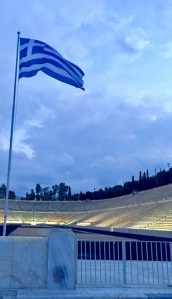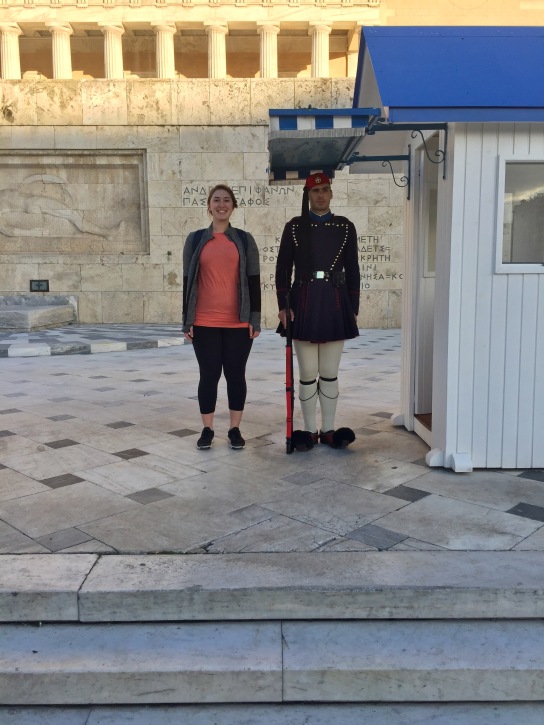Hello people! It’s been a few days since my last post because I’ve been pretty busy so I’ll do my best to catch you up to speed on everything I’ve been up to! We had a free day on Sunday and our professor invited us to join him on an
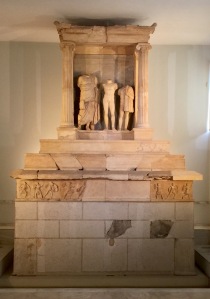
excursion to Athens’ harbor, to go to the Archaeological Museum of Piraeus and to see the ancient ship-sheds the Athenians used. I, of course, decided to join and had a great time walking through the museum and along the coast, despite the fact that it was only around 30 degrees. The museum we went to was full of things found in the harbor, which I thought was pretty cool. My personal favorite monument was one that depicted the Amazons because that is what my mother always called me growing up and it also happened to be one of the biggest and most impressive in the building. My only complaint is that wish the outdoor part of the museum was open so that I could check out the Theater of Zea.
We spent around an hour at the museum and then started the very long walk all the way around the coast to follow the wall that used to protect the harbor and take a peek at the ship-sheds.
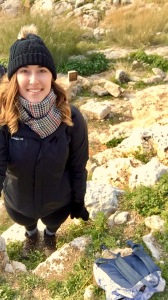
The strange thing about the sheds is that there are buildings built on top of them, so in order to see them, we had to peek through dirty windows into a basement. I did my best to take a picture, but all I could really get was a reflection of myself, so I had to give up on that endeavor. (I know it can’t only be me that has trouble wrapping my head around the way new things are just built on top of or right next to the old, but in a way that you’re able to use or admire both… it really is crazy to me.) I say this, not only because of the ship-shed situation (try saying that three times fast), but also because of how the ancient wall we followed along the coastline was incorporated into whatever it happened to run into apartment buildings, around restaurants…literally just anything. We walked about 10 miles on this little trip to the coast, which is a lot for someone who complains about a 3 minute walk to the caf, but I had a great time so I guess it was worth it.
These past 2 days have been spent exploring the Acropolis area. We spent a lot of our time huddled together with numb hands and runny noses listening to lectures about each of the building’s histories. It was very interesting, but also very, very cold. I was most excited to see the Erechtheion which is one of the temples up on the hill. It’s impressive because it used to house the sacred wooden statue of Athena, it is apparently where the salt water spring was given to the Athenians by Poseidon, the olive tree that was given by Athena grew right outside AND the Caryatids stand holding up the roof and eternally pouring libations over the grave of the mythical king of Athens, Cecrops. So much in one building, that’s why I love it! The Parthenon is magnificent as well, but I had much more fun exploring the caves on the North Slope and climbing all over the Areopagus. That could just be that it was slightly windy and I was able to move around and stay warm. As I mentioned earlier though, I really enjoy the myths about the Amazons and it just so happens that the Areopagus is where they set up base to fight the Athenians in order to rescue their queen. Pretty cool right?! In later times, the Athenians used the hill as a court for intentional homicide and if you’re familiar with the bible, Paul also delivered a Sermon while standing on top. That’s a lot of history for it just being a giant rock. I ended my day with a glass of 7 star Brandy from Brettos, the oldest distillery in Athens. It was a very small, cozy bar. Two of the walls were covered with different colored bottles from floor to ceiling, while the other had barrels of brandy sitting in front, it really was something else. Oh and the brandy…that was something else too. I can’t even begin to describe the taste, all I can say is to come try it yourself one day. I was intrigued when he said they make it right there but he caught me when he said there were hints of chocolate. And just to let you know, I’m a pretty big girl who’s done her fair share of drinking, and that one glass had me sitting at a perfect level. I can only imagine what would’ve happened if I had drank anymore, but I’m a responsible human so I decided to call it a night and raced through the cold back to the apartment.
This morning I arose to a beautiful surprise of a snowy city! Being from Texas, I’m required to be amazed by snow and as we were struggling to walk to the Acropolis Museum, I couldn’t have been any happier! As it turns out, even the natives were somewhat intrigued by the snow and they kept stopping and taking pictures too. Which made me feel like I looked much less like a tourist than before.
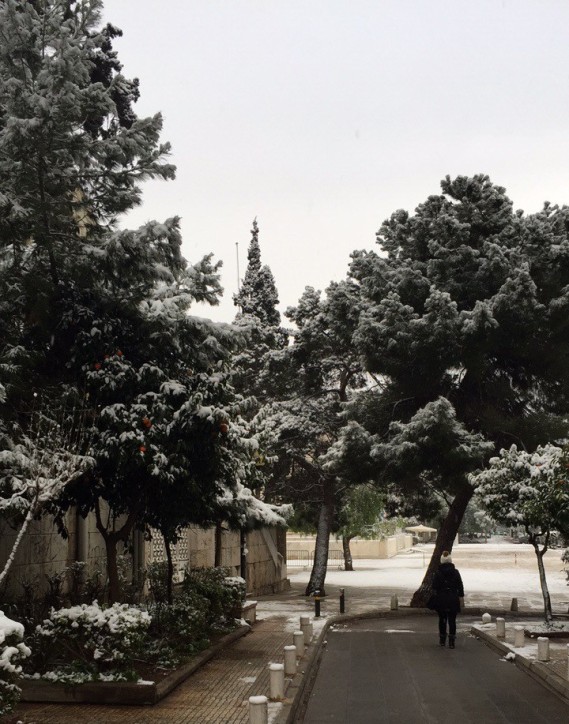
We spent a few hours ambling around the museum, looking at the amazing artifacts all found on the Acropolis. Not only were the items in the museum breathtaking but the architecture of the museum itself was incredible. The floors were see-through so that you could stand directly on top of a dig site and look at all the ruins. The top floor of the museum, which contained the Parthenon’s metopes, pediments and frieze was oriented exactly like the Parthenon, with the sculpture work wrapping around the room so that you could see exactly how it sat on the building. The design of the building was so helpful in picturing how things once were. To see the size of many of the sculptures was really surprising to me. Deep down I knew they were big, but you don’t really feel it until it’s sitting right in front of you. The time and effort it took to make everything is just astonishing and there was so much detail and artistry in every single one, I honestly can’t even comprehend it.
Aside from constantly being amazed, I spent the rest of the day doing laundry, grocery shopping and writing this. So congratulations you are now all caught up with my adventures thus far! As a little side note, mostly for me to remember this later. The top three things I’ve brought with me on this trip have been my hiking boots, scarf and selfie stick (cringe worthy I know, but they are handy.) So shout out to them..I would not have survived the Greece snowpocalypse without them and been able to take a selfie to prove it! We’re about to spend three days visiting various archeological sites, so stay tuned!
A quote that was written in the museum in Piraeus that I think sums up the entire reason the Athenians gifted us with the likes of the Parthenon:
“The human race tends to remember the abuses to which it has been subjected rather than the endearments.
Whats left of kisses?
Wounds, however, leave scars.” -Bertolt Brecht





